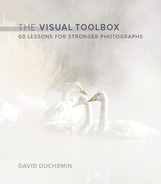Lesson 47. Orientation of Frame
Somewhere along the line someone got the goofy idea that a vertical orientation of the rectangular frame should be called a “portrait” orientation and the horizontal orientation should be called “landscape.” And so thousands of new photographers are given yet another ridiculous guideline that will hinder their creativity for years to come unless they stop thinking in these terms. If you search for tips on landscape photography you’ll find, over and over again, the helpful advice to “try landscapes in portrait orientation,” and conversely, a similar search for portrait tips will tell you to “try it in landscape orientation!” Great. The orientation of your frame should have nothing to do with the category of subject matter that you are photographing per se, and everything to do with what you are trying to say with each particular photograph. What do you want this photograph to look and feel like? Then do what you have to with the orientation of the frame. The first question is not “What shape is my subject?” There are plenty of great photographs who horizontally frame a vertical subject, and vice versa. The more interesting, and more helpful, question is, “Is the story to be read vertically or horizontally?”
Canon 5D, 17mm, 1/500 @ f/10, ISO 200
This is the same image, just cropped in Lightroom, showing the same scene in different orientations. The direction of the frame will make certain lines stronger than others and create a different sense of balance. In this case, one frame emphasizes the strong verticality of the scene, whereas the horizontal orientation allows the context to become much more important.
When we frame a photograph one way or the other we provide the first clues to readers about how you intend it to be read. You are saying not just “look here,” but “look in this direction.” It’s not that the reader usually needs to be told, but part of our job is to make decisions that put the fewest barriers possible between the audience and the thing we are trying to express or the experience we’re trying to create. A horizontal framing of an essentially vertical story is likely to require that we include much more in the frame than we need to, which means the reader has to sift through more, and her eyes will explore the image less directly, trying to sort out the heart of the story from the extraneous. And with every extraneous element, the impact of the necessary ones is diminished, resulting in a diluted photograph that’s not as strong as it could be.

Nikon D3s, 20mm, 1/320 @ f/2.5, ISO 400
Different orientations force new compositions and there is rarely one right answer. They express different things, and in this case provide slightly different information about the scene. I prefer the vertical frame for its energy and simplicity, but love the graceful arc of the well in the horizontal frame. You can rarely have it all in one frame.


